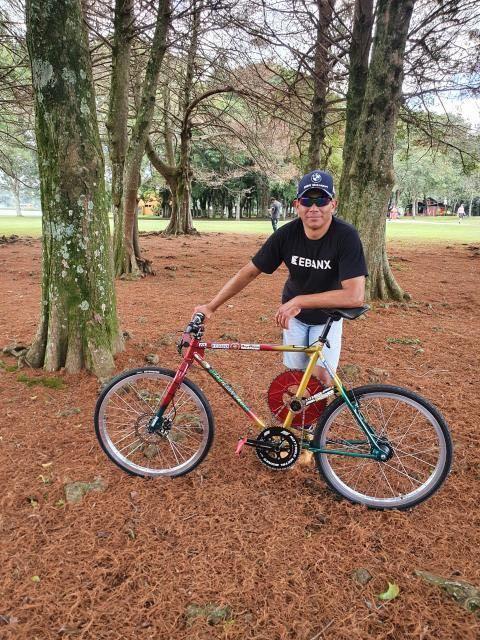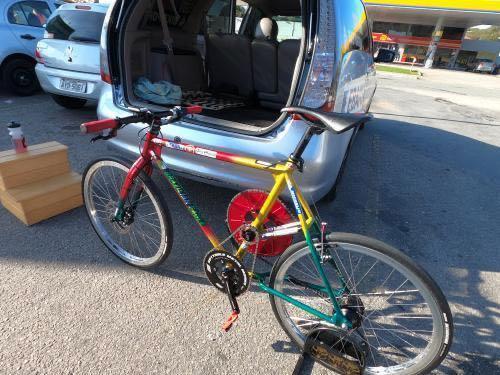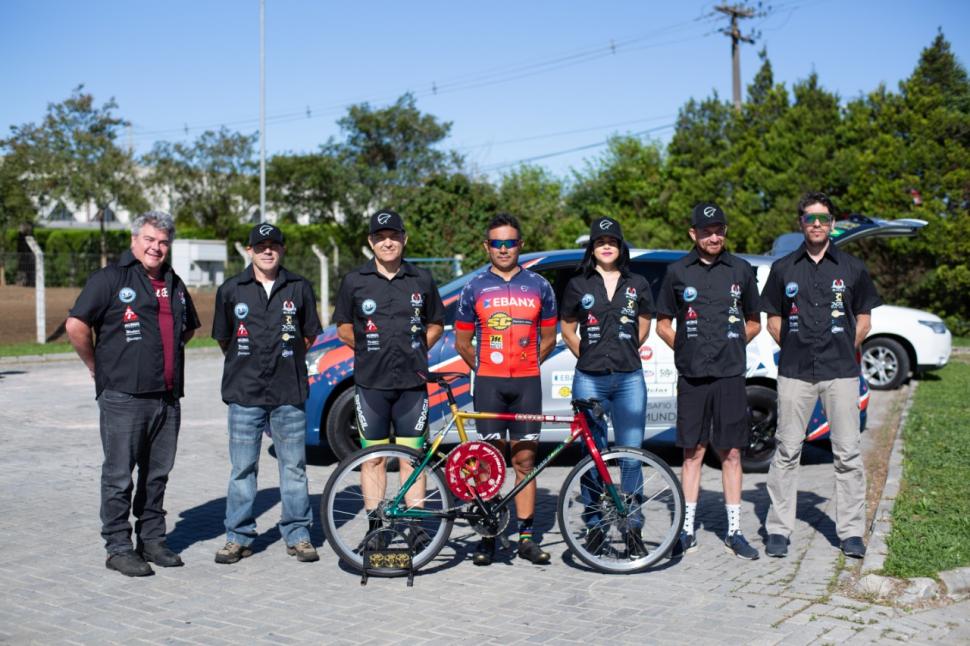- News
- Reviews
- Bikes
- Accessories
- Accessories - misc
- Computer mounts
- Bags
- Bar ends
- Bike bags & cases
- Bottle cages
- Bottles
- Cameras
- Car racks
- Child seats
- Computers
- Glasses
- GPS units
- Helmets
- Lights - front
- Lights - rear
- Lights - sets
- Locks
- Mirrors
- Mudguards
- Racks
- Pumps & CO2 inflators
- Puncture kits
- Reflectives
- Smart watches
- Stands and racks
- Trailers
- Clothing
- Components
- Bar tape & grips
- Bottom brackets
- Brake & gear cables
- Brake & STI levers
- Brake pads & spares
- Brakes
- Cassettes & freewheels
- Chains
- Chainsets & chainrings
- Derailleurs - front
- Derailleurs - rear
- Forks
- Gear levers & shifters
- Groupsets
- Handlebars & extensions
- Headsets
- Hubs
- Inner tubes
- Pedals
- Quick releases & skewers
- Saddles
- Seatposts
- Stems
- Wheels
- Tyres
- Health, fitness and nutrition
- Tools and workshop
- Miscellaneous
- Cross country mountain bikes
- Tubeless valves
- Buyers Guides
- Features
- Forum
- Recommends
- Podcast
feature
 Evandro Portela - 1.jpeg
Evandro Portela - 1.jpegBike at Bedtime: could this be the world’s fastest bike? No, really...
Brazilian rider Evandro Portela will attempt to beat the motor-paced cycling world record next year by riding at over 300km/h (186mph), and here is the bike he’ll be using.
If you’re not fully up to speed (ahem!) on the attempt, check out our story from last week. In short, Evandro plans to ride behind a 6.4-litre Chrysler 300C RST8, supercharged to 750 horsepower, on salt flats in Bolivia. He needs to exceed 296km/h (184mph) to secure the record and believes he can hit over 300 km/h.
> American woman smashes cycling land speed record, hitting nearly 184mph
Evandro became a viral hit a few years ago when drafting at 124km/h (77mph).
“ESA Bikes has done a great job,” says Evandro. “While everything was okay in 2020, I was going to go to Rourke’s small factory in the UK. I wanted to develop with them a similar bike to the one used by Guy Martin, but longer.”
Guy Martin achieved 179km/h (112mph) to set a British cycle speed record in 2014.
“Due to the COVID-19 pandemic that wasn’t possible, so we made one here [in Brazil] from chromoly steel,” says Evandro.
The top tube is a massive 68cm long while, in contrast, the seat tube is a far more normal 54cm.
The gearing from Nottable Metal Works is very different from a system you’ll find on a standard road bike. Hitting super-high speeds on an everyday design would be impossible – you’d either need a chainring way larger than is feasible or to pedal at several hundred revolutions per minute.
Like others attempting similar records, Evandro uses a compound gear system on this bike. A 55T chainring drives a 21T sprocket that’s attached to the seat tube. This sprocket turns a 73T chainring which drives a 16T sprocket attached to the hub of the rear wheel via a BMX chain. Get all that?
A compound gear system can turn the rear wheel much faster than is possible with a standard setup. Still, this system will need to be altered if Evandro is going to challenge the world record. The ratios aren’t big enough.
For Evandro to have the sprocket driving the rear wheel on the usual right side of the bike, the chainring attached to the crank has to be on the left.
The rest of the bike is a real mix of parts. Those are 32-hole Mavic wheels, for example, and the handlebar is from Bontrager.
Evandro has a Shimano Saint disc brake on the front – Saint being a top-level groupset for downhill mountain biking – and a V-brake on the back.
“In terms of safety, in the latest tests, training on public roads was easy at 140km/h (87mph) and 170km/h (106mph). I believe I can pass the barrier of 300km/h. There are four years of hard work here.”
Evandro is working with a team of people including an engineer, masseur, physical preparation trainer, mechanic, car driver, project director, and more technical support.
“[There are] no cables, only the breaking of the wind barrier behind a super powerful car. The challenge is hard. We will be training at 3,600 metres altitude. Uyuni salt flats in Bolivia are waiting for us.”
You can check out a series of Youtube videos following the making of the record attempt bike.
Mat has been in cycling media since 1996, on titles including BikeRadar, Total Bike, Total Mountain Bike, What Mountain Bike and Mountain Biking UK, and he has been editor of 220 Triathlon and Cycling Plus. Mat has been road.cc technical editor for over a decade, testing bikes, fettling the latest kit, and trying out the most up-to-the-minute clothing. He has won his category in Ironman UK 70.3 and finished on the podium in both marathons he has run. Mat is a Cambridge graduate who did a post-grad in magazine journalism, and he is a winner of the Cycling Media Award for Specialist Online Writer. Now over 50, he's riding road and gravel bikes most days for fun and fitness rather than training for competitions.
Latest Comments
- captain_slog 7 min 15 sec ago
These are all shown mounted to the seatpost. That's not always an option for me and I have one of these to mount a rear light horizontally: https:/...
- Destroyer666 32 min 17 sec ago
Well they had tools to whack out headset cups, so I guess a crank removal tool is just one tool among others in the bag. Or more likely - your...
- wtjs 47 min 57 sec ago
Surely, they can't be dim enough to sit on it for as long as possible and then claim 'something...something..GDPR..etc'? Can they?...
- KDee 1 hour 3 min ago
Most phones now have a decent IP rating so I wouldn't worry about a little condensation. Your sweat won't get into it and I don't think there's a...
- wtjs 1 hour 33 min ago
At least in Gloucestershire they write the advice down But they still refuse to tell you what it was?
- wtjs 1 hour 40 min ago
they have a hard upper cut-off so they don't dazzle...
- wtjs 1 hour 54 min ago
not only have I reported them for a close pass, which the police are taking further......
- auldain 2 hours 21 min ago
Halve the £15.49, and maybe, just maybe, I might consider staying.
- Dunnoeither 3 hours 9 min ago
My custom titanium frame from Waltly was 1150€ including shipping and customs. I can't see how this is supposed to be a money-no-object dream....



Add new comment
7 comments
.
By my reckoning he would need a cadence of around 200 to hit 300kph so I guess there will be a rebuild of the gearing.
Looking at that bike you could be excused for thinking today is 1st April not 1st December! 300k on that FFS?!?!
today is december 6th and we are alive speed land furia road
Cantilever on the back in some pictures, V brake in others. I wonder which of these classic and economical designs gives the best results in that tricky "slowing down from 300kph" situation?
rear brakes is just balance the mind dominates the matter
Ah... this explains that artwork from the other day, with the chainring on the wrong side, and seat stay braces.
not the most professional fabrication drawing I hae ever seen.